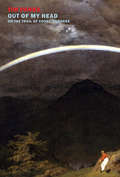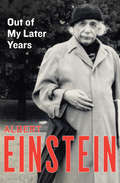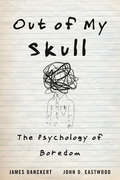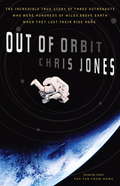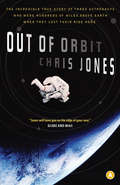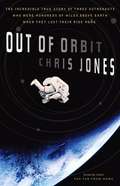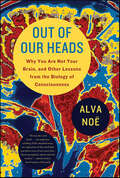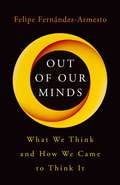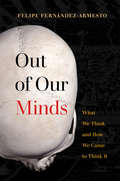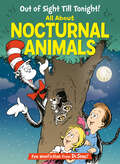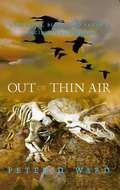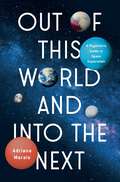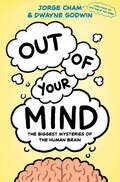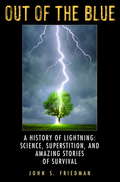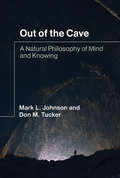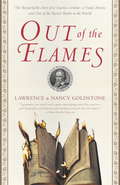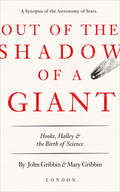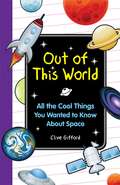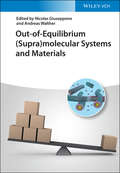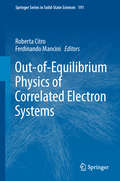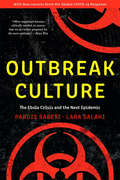- Table View
- List View
Out of My Head: On the Trail of Consciousness
by Tim ParksAdventures in cutting-edge ideas about consciousness, from bestselling non-fiction writer Tim Parks.Hardly a day goes by without some discussion about whether computers can be conscious, whether our universe is some kind of simulation, whether mind is a unique quality of human beings or spread out across the universe like butter on bread. Most philosophers believe that our experience is locked inside our skulls, an unreliable representation of a quite different reality outside. Colour, smell and sound, they tell us, occur only in our heads. Yet when neuroscientists look inside our brains to see what's going on, they find only billions of neurons exchanging electrical impulses and releasing chemical substances.Five years ago, in a chance conversation, Tim Parks came across a radical new theory of consciousness that undercut this interpretation. This set him off on a quest to discover more about this fascinating topic and also led him to observe his own experience with immense attention.Out of My Head tells the gripping, highly personal, often surprisingly funny, story of Tim Parks' quest to discover more about this fascinating topic. It frames complex metaphysical considerations and technical laboratory experiments in terms we can all understand. Above all, it invites us to see space, time, colour and smell, sounds and sensations in an entirely new way. The world will feel more real after reading it.
Out of My Later Years: The Scientist, Philosopher, and Man Portrayed Through His Own Words
by Albert EinsteinAn inspiring collection of essays, in which Albert Einstein addresses the topics that fascinated him as a scientist, philosopher, and humanitarian Divided by subject matter—&“Science,&” &“Convictions and Beliefs,&” &“Public Affairs,&” etc.—these essays consider everything from the need for a &“supranational&” governing body to control war in the atomic age to freedom in research and education to Jewish history and Zionism to explanations of the physics and scientific thought that brought Albert Einstein world recognition. Throughout, Einstein&’s clear, eloquent voice presents an idealist&’s vision and relays complex theories to the layperson. Einstein&’s essays share his philosophical beliefs, scientific reasoning, and hopes for a brighter future, and show how one of the greatest minds of all time fully engaged with the changing world around him. This authorized ebook features rare photos and never-before-seen documents from the Albert Einstein Archives at the Hebrew University of Jerusalem.
Out of My Later Years: The Scientist, Philosopher, and Man Portrayed Through His Own Words
by Albert EinsteinAn inspiring collection of essays, in which Albert Einstein addresses the topics that fascinated him as a scientist, philosopher, and humanitarian Divided by subject matter—&“Science,&” &“Convictions and Beliefs,&” &“Public Affairs,&” etc.—these essays consider everything from the need for a &“supranational&” governing body to control war in the atomic age to freedom in research and education to Jewish history and Zionism to explanations of the physics and scientific thought that brought Albert Einstein world recognition. Throughout, Einstein&’s clear, eloquent voice presents an idealist&’s vision and relays complex theories to the layperson. Einstein&’s essays share his philosophical beliefs, scientific reasoning, and hopes for a brighter future, and show how one of the greatest minds of all time fully engaged with the changing world around him. This authorized ebook features rare photos and never-before-seen documents from the Albert Einstein Archives at the Hebrew University of Jerusalem.
Out of My Skull: The Psychology of Boredom
by James Danckert John D. EastwoodNo one likes to be bored. Two leading psychologists explain what causes boredom and how to listen to what it is telling you, so you can live a more engaged life. We avoid boredom at all costs. It makes us feel restless and agitated. Desperate for something to do, we play games on our phones, retie our shoes, or even count ceiling tiles. And if we escape it this time, eventually it will strike again. But what if we listened to boredom instead of banishing it? Psychologists James Danckert and John Eastwood contend that boredom isn’t bad for us. It’s just that we do a bad job of heeding its guidance. When we’re bored, our minds are telling us that whatever we are doing isn’t working—we’re failing to satisfy our basic psychological need to be engaged and effective. Too many of us respond poorly. We become prone to accidents, risky activities, loneliness, and ennui, and we waste ever more time on technological distractions. But, Danckert and Eastwood argue, we can let boredom have the opposite effect, motivating the change we need. The latest research suggests that an adaptive approach to boredom will help us avoid its troubling effects and, through its reminder to become aware and involved, might lead us to live fuller lives. Out of My Skull combines scientific findings with everyday observations to explain an experience we’d like to ignore, but from which we have a lot to learn. Boredom evolved to help us. It’s time we gave it a chance.
Out of Orbit
by Chris JonesOn February 1, 2003, the nation was stunned to watch the shuttle Columbia disintegrate into a blue-green sky. Despite the numerous new reports surrounding the tragedy, the public remained largely unaware that three men, U.S. astronauts Donald Pettit and Kenneth Bowersox, and Russian flight engineer Nikolai Budarin, remained orbiting the earth. With the launch program suspended indefinitely, these astronauts, who were already near the end of a fourteen-week mission, had suddenly lost their ride home.Out of Orbit is the harrowing, behind-the-scenes chronicle of the efforts of beleaguered Mission Controls in Houston and Moscow who worked frantically against the clock to bring their men safely back to Earth, ultimately settling on a plan that felt, at best, like a long shot. Given that no shuttle could come for them, the astronauts' only hope for a return flight became a Russian-built Soyuz TMA-1 capsule, latched to the side of the space station--a piece of equipment roughly the equivalent of a "padded box attached to a parachute," with a troubled history (in 1971 a malfunction in the Soyuz 11 capsule left three Russian astronauts dead) and dated technology. Gripping and faced-paced, Out of Orbit is an adventure in outer space that will keep you on the edge of your seat. In a day and age when space travel is poised to become available to masses, Out of Orbit vividly captures both its hazardous realities and soaring majesty.
Out of Orbit: The True Story of How Three Astronauts Found Themselves Hundreds of Miles Above the Earth With No Way Home
by Chris JonesIn February 2003, American astronauts Donald Pettit and Kenneth Bowersox and Russian flight engineer Nikolai Budarin were on a routine fourteen-week mission maintaining the International Space Station. But then the space shuttle Columbia exploded far beneath them. With the launch program suspended indefinitely, these astronauts had suddenly lost their ride back to earth. Out of Orbit chronicles the efforts of the beleaguered mission controls in Houston and Moscow as they worked frantically against the clock, ultimately settling on a plan that felt, at best, like a long shot. Latched to the side of the space station was a Russian-built Soyuz TMA-1 capsule, the rocket equivalent of a 1976 Gremlin. Despite the inherent danger, the Soyuz became the only hope to return Bowersox, Budarin, and Pettit home. Their harrowing journey back to earth is a powerful reminder that space travel remains an incredibly dangerous pursuit.
Out of Orbit: The True Story of How Three Astronauts Found Themselves Hundreds of Miles Above the Earth with No Way Home
by Chris JonesAn adventure set on the most dangerous frontier of all--outer space. In the nearly forty years since Neil Armstrong walked on the moon, space travel has come to be seen as a routine enterprise--at least until the shuttle "Columbia" disintegrated.
Out of Our Heads: Why You Are Not Your Brain, and Other Lessons from the Biology of Consciousness
by Alva NoëAlva Noë is one of a new breed—part philosopher, part cognitive scientist, part neuroscientist—who are radically altering the study of consciousness by asking difficult questions and pointing out obvious flaws in the current science. In Out of Our Heads, he restates and reexamines the problem of consciousness, and then proposes a startling solution: Do away with the two hundred-year-old paradigm that places consciousness within the confines of the brain.Our culture is obsessed with the brain—how it perceives; how it remembers; how it determines our intelligence, our morality, our likes and our dislikes. It's widely believed that consciousness itself, that Holy Grail of science and philosophy, will soon be given a neural explanation. And yet, after decades of research, only one proposition about how the brain makes us conscious—how it gives rise to sensation, feeling, and subjectivity—has emerged unchallenged: We don't have a clue.In this inventive work, Noë suggests that rather than being something that happens inside us, consciousness is something we do. Debunking an outmoded philosophy that holds the scientific study of consciousness captive, Out of Our Heads is a fresh attempt at understanding our minds and how we interact with the world around us.
Out of Our Minds: What We Think and How We Came to Think It
by Felipe Fernández-Armesto&‘Immensely learned and ambitious…seam-bursting eclecticism and polymathic brio… This is by any standards a significant book and its author deserves high praise.&’ Literary ReviewTo imagine – to see that which is not there – is the startling ability that has fuelled human development and innovation through the centuries. As a species we stand alone in our remarkable capacity to refashion the world after the pictures in our minds. Traversing the realms of science, politics, religion, culture, philosophy and history, Felipe Fernández-Armesto reveals the thrilling and disquieting tales of our imaginative leaps. Through groundbreaking insights in cognitive science, he explores how and why we have ideas in the first place, providing a tantalising glimpse into who we are and what we might yet accomplish. Fernández-Armesto shows that bad ideas are often more influential than good ones; that the oldest recoverable thoughts include some of the best; that ideas of Western origin often issued from exchanges with the wider world; and that the pace of innovative thinking is under threat.
Out of Our Minds: What We Think and How We Came to Think It
by Felipe Fernández-ArmestoTo imagine—to see what is not there—is the startling ability that has fueled human development and innovation through the centuries. As a species we stand alone in our remarkable capacity to refashion the world after the picture in our minds. Traversing the realms of science, politics, religion, culture, philosophy, and history, Felipe Fernández-Armesto reveals the thrilling and disquieting tales of our imaginative leaps—from the first Homo sapiens to the present day. Through groundbreaking insights in cognitive science, Fernández-Armesto explores how and why we have ideas in the first place, providing a tantalizing glimpse into who we are and what we might yet accomplish. Unearthing and historical evidence, he begins by reconstructing the thoughts of our Paleolithic ancestors to reveal the subtlety and profundity of the thinking of early humans. A masterful paean to the human imagination from a wonderfully elegant thinker, Out of Our Minds shows that bad ideas are often more influential than good ones; that the oldest recoverable thoughts include some of the best; that ideas of Western origin often issued from exchanges with the wider world; and that the pace of innovative thinking is under threat.
Out of Sight Till Tonight! All About Nocturnal Animals: All About Nocturnal Animals (The Cat in the Hat's Learning Library)
by Tish RabeLaugh and learn with fun facts about raccoons, wolves, fireflies, and more—all told in Dr. Seuss&’s beloved rhyming style and starring the Cat in the Hat! &“I&’m the Cat in the Hat and tonight we&’ll take flight and meet some of the critters that come out at night.&” The Cat in the Hat&’s Learning Library series combines beloved characters, engaging rhymes, and Seussian illustrations to introduce children to non-fiction topics from the real world! Stay up past your bedtime and discover the world of nocturnal animals, including: • how bats use echolocation• why some desert animals hunt at night• how toads need to stay damp to survive• and much more! Perfect for story time and for the youngest readers, Out of Sight Till Tonight! All About Nocturnal Animals also includes an index, glossary, and suggestions for further learning. Look for more books in the Cat in the Hat&’s Learning Library series!If I Ran the Horse Show: All About HorsesClam-I-Am! All About the BeachMiles and Miles of Reptiles: All About ReptilesA Whale of a Tale! All About Porpoises, Dolphins, and WhalesSafari, So Good! All About African WildlifeThere's a Map on My Lap! All About MapsOh, the Lavas That Flow! All About VolcanoesWhat Cat Is That? All About CatsOnce upon a Mastodon: All About Prehistoric MammalsOh Say Can You Say What's the Weather Today? All About WeatherThe Cat on the Mat: All About Mindfulness
Out of Thin Air
by Peter WardFor 65 million years dinosaurs ruled the Earth--until a deadly asteroid forced their extinction. But what accounts for the incredible longevity of dinosaurs? A renowned scientist now provides a startling explanation that is rewriting the history of the Age of Dinosaurs. Dinosaurs were pretty amazing creatures--real-life monsters that have the power to fascinate us. And their fiery Hollywood ending only serves to make the story that much more dramatic. But fossil evidence demonstrates that dinosaurs survived several mass extinctions, and were seemingly unaffected by catastrophes that decimated most other life on Earth. What could explain their uncanny ability to endure through the ages? Biologist and earth scientist Peter Ward now accounts for the remarkable indestructibility of dinosaurs by connecting their unusual respiration system with their ability to adapt to Earth's changing environment--a system that was ultimately bequeathed to their descendants, birds. By tracing the evolutionary path back through time and carefully connecting the dots from birds to dinosaurs, Ward describes the unique form of breathing shared by these two distant relatives and demonstrates how this simple but remarkable characteristic provides the elusive explanation to a question that has thus far stumped scientists. Nothing short of revolutionary in its bold presentation of an astonishing theory, Out of Thin Air is a story of science at the edge of discovery. Ward is an outstanding guide to the process of scientific detection. Audacious and innovative in his thinking, meticulous and thoroughly detailed in his research, only a scientist of his caliber is capable of telling this surprising story.
Out of This World and Into the Next: A Physicist's Guide to Space Exploration
by Adriana MaraisA theoretical physicist's grand tour of how life emerged on Earth and how human civilization will begin expanding beyond our home planet.This is a theoretical physicist&’s grand tour of how life emerged on Earth and, perhaps most importantly, how human civilization will begin expanding beyond our home planet. According to Dr. Adriana Marais, living on more than one planet is an inevitability of becoming a more advanced society, but the process of getting there will provide us with the essential tools for better stewardship of our own. Humanity has always looked up at the night sky and wondered what lies beyond our world. Now, we are on the precipice of stepping out among the stars, not just as lone astronauts or billionaire tech bros, but as a civilization. Our story is one of curiosity and an innate desire to explore and understand not only the world around us, but the world within us, and the worlds above us, from extremophiles to extraterrestrials, technosignatures to terraforming, DNA to Dyson Spheres. In this sweeping treatise on exploration, innovation, and human ingenuity, theoretical physicist Dr. Adriana Marais seeks to answer the questions that stand at the heart of scientific endeavor: What are the building blocks of life and how does life emerge? Are we alone in the universe and if so, why? How did we get here—and where are we going next?
Out of This World: Poems and Facts about Space
by Amy SklanskyAmy Sklansky and Stacey Schuett give young explorers the moon and stars and beyond! The mysteries of the universe and the science of space exploration are perennialy popular subjects, and Out of This World is a wonderful introduction. Amy Sklansky has written evocative poems about planets and stars and rockets and moon landings and satellites. Each poem is supported by additional facts and explanations in the margins. Stacey Schuett brings it all to life with color-soaked skies and beautiful perspectives in her fabulous paintings. Space is a subject too grand for poetry or prose alone, so this book offers both to help readers truly appreciate our place in space.
Out of This World: The principles of high performance and perfect decision making learned from leading at NASA
by Paul Sean HillFailure is always an option...For more than 50 years, NASA's Mission Control has been known for two things: perfect decision making in extreme situations and producing generations of steely-eyed missile men and women who continue that tradition. A key to that legacy of brilliant performance is a particular brand of leadership, especially at the working level in Mission Control.Take the ultimate insiders look at the leadership values and culture that created the best team on this planet. Paul Sean Hill was responsible for NASA's Mission Operations support for manned space flight from 2007-2011. In this candid book he shows that the secret to Mission Control's success has never been rocket science and that the real practice of perfect decision making can be applied to any organisation or team. By demonstrating how his Mission Control team nurtured a culture which has delivered impossible wins for decades, Hill provides a guide for all leaders to boost their company's performance at all levels.Whether failure means cost and schedule overruns, quality reduction, loss of market share, bankruptcy - or putting someone's life a risk, how we lead can determine whether even small mistakes are dealt with or are left to snowball out of control and destroy an enterprise. Discover how to take leadership from the Mission Control Room to your boardroom and beyond, and achieve this out-of-this-world leadership environment in your team.
Out of Your Mind: The Biggest Mysteries of the Human Brain
by Jorge Cham Dwayne GodwinFrom the creator of WE HAVE NO IDEA, an introductory journey into your own mind—if your inner voice had a Ph.D. in brain science, cracked jokes, and drew cartoons.Why do you love? Why do you lie? What makes you happy? Every single thought you have comes from one place: your brain. But what makes it tick? How much of it have we decoded, and how much of it remains an impenetrable mystery? Join best-selling author and online cartoonist Jorge Cham and neuroscientist Dwayne Godwin on a deep dive into the fascinating world of the human brain, in which they will explore questions such as: What is consciousness? Where is you in the brain? And do we have free will? All while illuminating everything we know (and DON&’T know) about one of the most complex objects in the known universe. Think of it as conversation-ammunition for your next cocktail party, or a quick fascinating read while you&’re in the bathroom (don&’t worry, the chapters aren&’t that long). Centered around questions we all ask ourselves at some point but don&’t usually have answers to, Out of Your Mind is an illustrated book about the brain that isn&’t too brainy. Playful, accessible, and deeply insightful, it&’s the one brain book that&’s truly accessible and suitable for all brains.
Out of the Blue
by John S. FriedmanThe odds of being hit by lightning each year are only about 1 in 750,000 in the U. S. And yet this rare phenomenon has inspired both fear and fascination for thousands of years. In this groundbreaking, brilliantly researched book, journalist John S. Friedman probes lightning’s scientific, spiritual, and cultural roots. Blending vibrant history with riveting first-hand accounts of those who have clashed with lightning and lived to tell about it,Out of the Bluecharts an extraordinary journey across the ages that explores our awe and dread in the face of one of nature’s most fearsome spectacles. Herman Melville called it “God’s burning finger. ” The ancient Romans feared it as the wrath of God. Today we have a more scientific understanding, so why our eternal fascination with lightning?Out of the Blueattempts to understand this towering force of nature, exploring the changing perceptions of lightning from the earliest civilizations through Ben Franklin’s revolutionary experiments to the hair-raising adventures of storm chasers like David Hoadley, who’s been chronicling extreme weather for half a century. And Friedman describes one of the most treacherous rescues ever attempted in American mountain climbing. Friedman profiles a Virginia ranger who was struck by lightning seven times—and dubbed the human lightning rod—along with scores of others who tell astonishing tales of rescue and survival. And he charts lightning’s profound, life-altering effects on the emotional and spiritual lives of its victims. Combining captivating fact with thrilling personal stories,Out of the Bluetells a remarkable true tale of fate and coincidence, discovery and divine retribution, science and superstition. As entertaining as it is informative, it is a book for outdoor adventurers, sports enthusiasts, science and weather buffs, nature lovers, and anyone who has ever been awed or frightened by the sight of lightning. From the Hardcover edition.
Out of the Cave: A Natural Philosophy of Mind and Knowing
by Mark L. Johnson Don M. TuckerFrom a philosopher and a neuropsychologist, a radical rethinking of certain traditional views about human cognition and behavior.Plato's Allegory of the Cave trapped us in the illusion that mind is separate from body and from the natural and physical world. Knowledge had to be eternal and absolute. Recent scientific advances, however, show that our bodies shape mind, thought, and language in a deep and pervasive way. In Out of the Cave, Mark Johnson and Don Tucker--a philosopher and a neuropsychologist--propose a radical rethinking of certain traditional views about human cognition and behavior. They argue for a theory of knowing as embodied, embedded, enactive, and emotionally based. Knowing is an ongoing process--shaped by our deepest biological and cultural values. Johnson and Tucker describe a natural philosophy of mind that is emerging through the convergence of biology, psychology, computer science, and philosophy, and they explain recent research showing that all of our higher-level cognitive activities are rooted in our bodies through processes of perception, motive control of action, and feeling. This developing natural philosophy of mind offers a psychological, philosophical, and neuroscientific account that is at once scientifically valid and subjectively meaningful--allowing us to know both ourselves and the world.
Out of the Flames: The Strange Journey of Michael Servetus and One of the Rarest Books in the World
by Lawrence Goldstone Nancy GoldstoneMichael Servetus is one of those hidden figureheads of history who is remembered not for his name, but for the revolutionary deeds that stand in his place. Both a scientist and a freethinking theologian, Servetus is credited with the discovery of pulmonary circulation in the human body as well as the authorship of a polemical masterpiece that cost him his life. The Chrisitianismi Restituto, a heretical work of biblical scholarship, written in 1553, aimed to refute the orthodox Christianity that Servetus' old colleague, John Calvin, supported. After the book spread through the ranks of Protestant hierarchy, Servetus was tried and agonizingly burned at the stake, the last known copy of the Restitutio chained to his leg. Servetus's execution is significant because it marked a turning point in the quest for freedom of expression, due largely to the development of the printing press and the proliferation of books in Renaissance Europe. Three copies of the Restitutio managed to survive the burning, despite every effort on the part of his enemies to destroy them. As a result, the book became almost a surrogate for its author, going into hiding and relying on covert distribution until it could be read freely, centuries later. Out of the Flames tracks the history of this special work, examining Servetus's life and times and the politics of the first information during the sixteenth century. Lawrence and Nancy Goldstone follow the clandestine journey of the three copies through the subsequent centuries and explore its author's legacy and influence over the thinkers that shared his spirit and genius, such as Leibniz, Voltaire, Rousseau, Jefferson, Clarence Dorrow, and William Osler. Out of the Flames is an extraordinary story providing testament to the power of ideas, the enduring legacy of books, and the triumph of individual courage.
Out of the Shadow of a Giant: Hooke, Halley, & the Birth of Science
by John Gribbin Mary GribbinThe authors of Ice Age &“present a well-documented argument that [Newton] owed more to the ideas of others than he admitted&” (Kirkus Reviews). Robert Hooke and Edmond Halley, whose place in history has been overshadowed by the giant figure of Newton, were pioneering scientists within their own right, and instrumental in establishing the Royal Society. Although Newton is widely regarded as one of the greatest scientists of all time and the father of the English scientific revolution, John and Mary Gribbin uncover the fascinating story of Robert Hooke and Edmond Halley, whose scientific achievements neatly embrace the hundred years or so during which science as we know it became established. They argue persuasively that, even without Newton, science would have made a great leap forward in the second half of the seventeenth century, headed by two extraordinary figures, Hooke and Halley. &“Science readers will thank the Gribbins for restoring Hooke and Halley to the prominence that they deserve.&”—Publishers Weekly &“Engaging . . . They offer proof that Hooke was an important scientist in his own right, and often had physical insights that were borrowed (usually without acknowledgement) by Newton.&”—Choice
Out of this World
by Clive GiffordAre you baffled by the Big Bang? Curious about what it's like to walk on the moon? Wondering if someday you might meet an alien? Dreaming of becoming an astronaut? This fun, comprehensive book is bursting with all the cool things you ever wanted to know about space. In Out of Space you will discover . . .· The Earth, the Moon, and in Between--From the birth of our planet and its fascinating blueprint to its amazing atmosphere and our nearest neighbor, the moon!· Earth's Neighborhood--From the eight planets in our solar system and the characteristics that set them apart to the mystifying facts about comets and meteoroids.· Seething Stars and Giant Galaxies--From the life of the star and its various sizes and shapes to the 200 billion that make up the Milky Way.· Stargazing--From the accounts and theories of the ancient astronomers to today's scientists and their search for the extraterrestrial.· Exploring Space--From the first-known rockets to today's mighty spacecraft and the famous missions that advanced our exploration.· How It All Began . . . and Might End--From scientists' theories about the dawn of time to the fierce debate about how, when--and if--the universe may end someday.
Out on a Limb
by Benjamin KilhamIn Out on a Limb, Ben Kilham invites us into the world he has come to know best: the world of black bears. For decades, Kilham has studied wild black bears in a vast tract of Northern New Hampshire woodlands. At times, he has also taken in orphaned infants-feeding them, walking them through the forest for months to help them decipher their natural world, and eventually reintroducing them back into the wild. Once free, the orphaned bears still regard him as their mother. And one of these bears, now a 17-year-old female, has given him extraordinary access to her daily life, opening a rare window into how she and the wild bears she lives among carry out their daily lives, raise their young, and communicate. Witnessing this world has led to some remarkable discoveries. For years, scientists have considered black bears to be mostly solitary. Kilham's observations, though, reveal the extraordinary interactions wild bears have with each other. They form friendships and alliances; abide by a code of conduct that keeps their world orderly; and when their own food supplies are ample, they even help out other bears in need. Could these cooperative behaviors, he asks, mimic behavior that existed in the animal that became human? In watching bears, do we see our earliest forms of communications unfold? Kilham's dyslexia once barred him from getting an advanced academic degree, securing funding for his research, and publishing his observations in the scientific literature. After being shunned by the traditional scientific community, though, Kilham's unique findings now interest bear researchers worldwide. His techniques even aid scientists working with pandas in China and bears in Russia. Moreover, the observation skills that fueled Kilham's exceptional work turned out to be born of his dyslexia. His ability to think in pictures and decipher systems makes him a unique interpreter of the bear's world. Out on a Limb delivers Kilham's fascinating glimpse at the inner world of bears, and also makes a passionate case for science, and education in general, to open its doors to different ways of learning and researching-doors that could lead to far broader realms of discovery. Kilham and his work have been featured in five internationally televised documentaries. In addition to being on over forty nationally broadcast radio shows including National Public Radio, he has appeared on The Today Show, Good Morning America, ABC Nightly News, The David Letterman Show, and more.
Out-of-Equilibrium (Supra)molecular Systems and Materials
by Nicolas GiusepponeA must-have resource that covers everything from out-of-equilibrium chemical systems and materials to dissipative self-assemblies Out-of-Equilibrium Supramolecular Systems and Materials presents a comprehensive overview of the synthetic approaches that use supramolecular bonds in various out-of-thermodynamic equilibrium situations. With contributions from noted experts on the topic, the text contains information on the design of dissipative self-assemblies that maintain their structures when fueled by an external source of energy. The contributors also examine molecules and nanoscale objects and materials that can produce mechanical work based on molecular machines. Additionally, the book explores non-equilibrium supramolecular polymers that can be trapped in kinetically stable states, as well as out-of-equilibrium chemical systems and oscillators that are important to understand the emergence of complex behaviors and, in particular, the origin of life. This important book: Offers comprehensive coverage of fields from design of dissipative self-assemblies to non-equilibrium supramolecular polymers Presents information on a highly emerging and interdisciplinary topic Includes contributions from internationally renowned scientists Written for chemists, physical chemists, biochemists, material scientists, Out-of-Equilibrium Supramolecular Systems and Materials is an indispensable resource written by top scientists in the field.
Out-of-Equilibrium Physics of Correlated Electron Systems (Springer Series in Solid-State Sciences #191)
by Ferdinando Mancini Roberta CitroThis book is a wide-ranging survey of the physics of out-of-equilibrium systems of correlated electrons, ranging from the theoretical, to the numerical, computational and experimental aspects. It starts from basic approaches to non-equilibrium physics, such as the mean-field approach, then proceeds to more advanced methods, such as dynamical mean-field theory and master equation approaches. Lastly, it offers a comprehensive overview of the latest advances in experimental investigations of complex quantum materials by means of ultrafast spectroscopy.
Outbreak Culture: The Ebola Crisis and the Next Epidemic, With a New Preface and Epilogue
by Pardis Sabeti Lara SalahiA Choice Outstanding Academic Title of the Year “A critical, poignant postmortem of the epidemic.” —Washington Post “Forceful and instructive…Sabeti and Salahi uncover competition, sabotage, fear, blame, and disorganization bordering on chaos, features that are seen in just about any lethal epidemic.” —Paul Farmer, cofounder of Partners in Health “The central theme of the book…is that common threads of dysfunction run through responses to epidemics…The power of Outbreak Culture is its universality.” —Nature “Sabeti and Salahi present a wealth of evidence supporting the imperative that outbreak response must operate in a coordinated, real-time manner.” —Science As we saw with the Ebola outbreak—and the disastrous early handling of the COVID-19 coronavirus pandemic—a lack of preparedness, delays, and system-wide problems with the distribution of critical medical supplies can have deadly consequences. Yet after every outbreak, the systems put in place to coordinate emergency responses are generally dismantled. One of America’s top biomedical researchers, Dr. Pardis Sabeti, and her Pulitzer Prize–winning collaborator, Lara Salahi, argue that these problems are built into the ecosystem of our emergency responses. With an understanding of the path of disease and insight into political psychology, they show how secrecy, competition, and poor coordination plague nearly every major public health crisis and reveal how much more could be done to safeguard the well-being of caregivers, patients, and vulnerable communities. A work of fearless integrity and unassailable authority, Outbreak Culture seeks to ensure that we make some urgently needed changes before the next pandemic.
